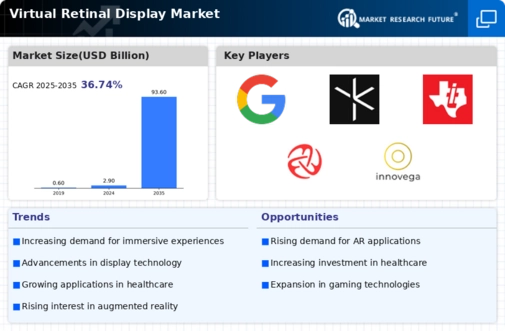Top Industry Leaders in the Virtual Retinal Display Market

Competitive Landscape of Virtual Retinal Display Market:
The virtual retinal display (VRD) market is a burgeoning space brimming with immense potential. Unlike traditional head-mounted displays (HMDs), VRDs project images directly onto the retina, offering superior visual fidelity and a wider field of view. This revolutionary technology is poised to disrupt various industries, from gaming and entertainment to healthcare and defense.
Some of the Virtual Retinal Display companies listed below:
- Google Inc
- Avegant Corporation
- Occulus VR
- Human Interface Technology Laboratory
- Magic Leap
- Texas Instruments
- Microvision Inc
- Vuzix Corp
- Sony Corp.
- HTC Corp.
Strategies Adopted by key players:
The VRD market is witnessing fierce competition among established players and emerging startups. Key players are adopting various strategies to gain a competitive edge, including:
- Product innovation: Companies are constantly innovating to develop new features and functionalities for their VRD products. For instance, Avegant Corporation has introduced its next-generation VRD system, the LightForm Lx1, which boasts a wider field of view and improved resolution compared to its predecessors.
- Strategic partnerships: Collaborations between VRD companies and other technology players are becoming increasingly common. For example, Magic Leap partnered with Microsoft to integrate its VRD technology with the HoloLens platform.
- Focus on specific applications: Companies are targeting specific application areas to gain market share. For example, QD Laser is focusing on developing VRDs for the medical field, while Texas Instruments is concentrating on VRD solutions for industrial applications.
Factors for Market Share Analysis:
Several factors can influence a company's market share in the VRD market, including:
- Technological expertise: Companies with strong expertise in laser technology, micro-optics, and retinal scanning are likely to have a competitive advantage.
- Product portfolio: Companies offering a wider range of VRD products with diverse features and functionalities are more likely to attract a larger customer base.
- Brand recognition: Established companies with strong brand recognition have an edge over newcomers in terms of market awareness and customer trust.
- Price competitiveness: VRDs are currently expensive, and companies offering competitive pricing strategies are more likely to gain traction in the market.
- Distribution network: A strong distribution network is crucial for reaching a wider audience and ensuring product availability.
New and Emerging Players:
The VRD market is attracting a growing number of new and emerging companies, bringing fresh ideas and innovative approaches to the table. Some of the notable startups in the space include:
- Mojo Vision: This company is developing a smart contact lens with a built-in VRD display, offering a truly hands-free and unobtrusive way to access information.
- Nreal: This Chinese company has developed lightweight and affordable VRD glasses aimed at the consumer market.
- Vuzix Corporation: This company offers a range of VRD smart glasses for various industrial and enterprise applications.
Latest Company Updates:
On Oct.17, 2023, at CEATEC 2023, TDK showcased its latest smart glasses with a full-color laser module, Direct Retinal Projection System. The company has been working on this technology for several years, enabling a head-mounted display experience. TDK's Direct Retinal Projection System could be utilized in XR headsets, projecting an image directly onto the retina instead of a display surface the user is looking at.
On Oct.18, 2022, at CEATEC 2022, TDK Corporation displayed its smart glasses equipped with the smallest ever class ultra-compact full-color laser module (FCLM) under development by TDK. The demonstration included the projection made possible for the eyes of the laser direct retinal projection glasses using the FCLM, overcoming the long-standing issue of displays with a narrow viewing angle. The FCLM was jointly developed with Nippon Telegraph and Telephone (NTT) by incorporating a Planar Lightwave Circuit (PLC) technology.
On Aug.06, 2023, At Siggraph 2023, Meta showcased a research prototype that combines a core VR technology with ultra-high pixel density. Meta built a virtual reality headphone with a retinal resolution varifocal display, a near retinal resolution, and an angular pixel density of up to 56 pixels per degree. The new VR head-mounted display supports a wide range of eye accommodation from 0 to 4 diopter and matches the dynamics of eye accommodation.
On April 27, 2021, WiMi Hologram Cloud Inc. (WIMI –the US), a leading hologram AR technology provider, announced receiving a patent for head-mounted display (HMD) for holographic AR systems using retina scanning display (RSD) and semi-permeable membrane array planar waveguide technology. The patent results from independent research & development are important to further improve WIMI's intellectual property protection system, maintain its leading position in technology, and enhance its core competitiveness.
